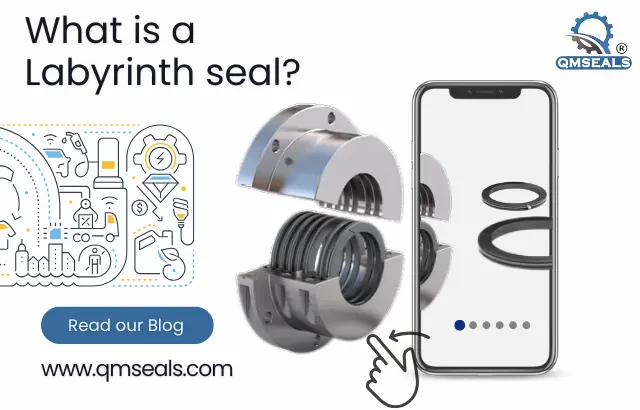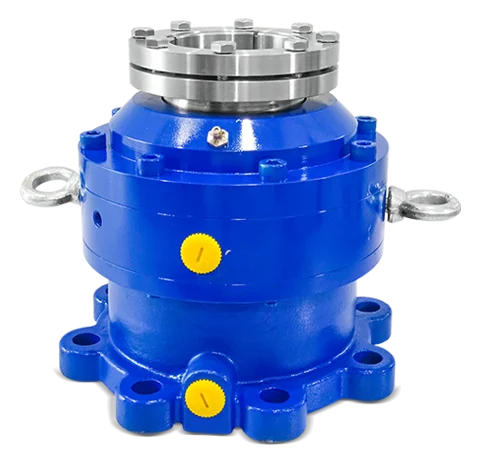Posted At: Mar 14, 2025 - 1,473 Views

What Is a Labyrinth Seal?
Sealing technology is an important aspect of industrial equipment, as it protects against leakage, minimizes contamination, and maintains the efficient running of rotating machinery. A labyrinth seal is one of the most effective and common sealing mechanisms applied in high-speed machinery. A labyrinth seal is used to prevent fluid, dust, and gas passage while minimizing wear and maximizing equipment life. But what is a labyrinth seal, how does it function, and what are the various types? Let's delve into all this about this life-saving sealing solution.
Understanding the Labyrinth Seal
A labyrinth seal is a mechanical seal that incorporates a series of complex paths to create a restriction in fluid or gas flow. Contrary to common seals that make use of direct contact with a rotating component or shaft, labyrinth seals operate under a non-contact principle and are, therefore, extremely efficient in curbing wear and increasing the equipment's service life.
The term labyrinth is derived from its distinctive structure—a convoluted combination of grooves, ridges, and chambers that render it hard for any gas or fluid to flow through. Labyrinth seals are found in most turbines, compressors, pumps, and motors, where they serve an important function of sealing against leakage and guarding delicate components from contamination.
How Does a Labyrinth Seal Work?
The operation of a labyrinth seal relies on the concept of providing several obstructions along the path of leakage. When air, oil, or gas tries to flow through the seal, it has to travel through a twisted, maze-like path, which greatly slows down its velocity and pressure. This configuration efficiently holds any contaminants or fluids in the grooves of the seal so that they cannot escape or enter the system.
Since labyrinth seals are non-contacting, they do not wear out like traditional mechanical seals, which rely on physical contact to create a seal. Instead, they use a combination of tight clearances, fluid dynamics, and pressure differentials to achieve an effective sealing mechanism. This makes them particularly useful in applications where high-speed rotation and minimal friction are critical.
Types of Labyrinth Seals
There are several different types of labyrinth seals, each designed for specific applications and operational conditions. Here are the most common types:
1. Radial Labyrinth Seal
A radial labyrinth seal consists of a series of ridges or teeth that project perpendicular to the shaft. The ridges form multiple seals that compel fluid or air to flow along a tortuous route, thus avoiding leakage. These are mostly utilized in rotating equipment like gas turbines and compressors.
2. Axial Labyrinth Seal
In contrast to radial labyrinth seals, an axial labyrinth seal contains grooves and ridges parallel to the shaft. This arrangement provides a long sealing path, which is ideal in situations involving axial motion or high rotational velocities. Axial labyrinth seals are used in jet engines and high-speed gearboxes.
3. Interlocking Labyrinth Seal
In an intermeshing labyrinth seal, the rotating and fixed components both possess complementary grooves that fit together without touching. This produces an even more complex path for the fluids to follow, which minimizes leakage greatly. Such seals are typically found in applications where efficient sealing must be achieved, like steam turbines and high-pressure compressors.
4. Stepped Labyrinth Seal
A stepped labyrinth seal has a staggered tooth and groove pattern, which raises the leakage path complexity. The stepped configuration is especially efficient in minimizing airflow and pressure loss and is ideal for application in high-speed rotating machinery like gas turbines and centrifugal compressors.
5. Floating Labyrinth Seal
A floating labyrinth seal is constructed with very little clearance between the rotating and stationary parts, enabling it to float a small amount when in motion. It is commonly employed in automotive turbochargers and high-speed bearings, where it offers efficient sealing with less friction and wear.
Advantages of Using a Labyrinth Seal
The labyrinth seal is characterized by numerous benefits over standard sealing techniques, and it is popular in high-speed industrial practice. The following are the major advantages:
1. Non-Contact Design for Reduced Wear
Because labyrinth seals do not involve direct contact between surfaces, they have less wear and tear over a period. This results in greater life service and lower maintenance costs than contact seals like lip seals or mechanical face seals.
2. Better Leak Prevention
The complex nature of labyrinth seals prevents air, oil, or gases from seeping out of or into the system easily. This is vital in applications such as gas turbines, steam turbines, and compressors with high speeds, where leakage must be prevented.
3. High-Speed Capability
In contrast to contact seals, which produce friction and heat at high speeds, labyrinth seals function normally even at very high rotational velocities. This makes them suitable for application in turbomachinery, jet engines, and high-speed pumps.
4. Minimal Maintenance Needs
As labyrinth seals are non-contacting types of seals, they need less maintenance than conventional sealing solutions. This minimizes downtime and running costs in industrial processes.
5. Harsh Environment Resistance
Labyrinth seals are very resistant to high temperatures, high pressures, and corrosive conditions and are therefore well-suited for application in chemical processing, power generation, and aerospace.
What Are the Temperature Limits of a Labyrinth Seal?
Labyrinth seals are commonly employed on rotating equipment to avoid leakage and contamination while still ensuring efficient performance. They work without physical contact, employing a sophisticated path of grooves to limit fluid or gas flow. Knowing their temperature capabilities is vital in choosing the appropriate seal for different industrial uses.
Temperature Ranges for Labyrinth Seals
The temperature range of a labyrinth seal varies with the seal material, operating condition, and type of application. Whereas typical metallic labyrinth seals have a resistance to temperatures -100 °C to 600°C, more advanced materials support even higher resistance.
Factors Influencing Labyrinth Seal Temperature Tolerance
Material Composition – Labyrinth seals are constructed from aluminum, stainless steel, bronze, or thermoplastics, with varying heat resistance. Metallic labyrinth seals are more resistant to higher temperatures than polymer-based ones.
Application Type
Various types of labyrinth seals are applied in gas turbines, compressors, and pumps, each exposed to different thermal conditions. Turbine seals tend to encounter extreme temperatures, while pump seals deal with moderate temperatures.
Operating Environment
The occurrence of high-speed rotation, pressure fluctuations, and heat sources affects the way a labyrinth seal behaves under temperature stress.
How Does a Labyrinth Seal Function in High Temperatures?
A labyrinth seal operates well at high temperatures by employing accurately designed grooves that form a controlled leakage path. Under extreme conditions, specially coated or materials such as carbon-filled PTFE improve thermal resistance.
Choosing the appropriate labyrinth seal type according to temperature needs guarantees longevity, efficiency, and low maintenance, which makes them critical in numerous industrial applications.
Where Are Labyrinth Seals Used?
Labyrinth seals are extensively applied across industries because they can offer effective sealing in high-temperature and high-speed conditions. Some of the most typical applications are:
Aerospace Industry: Applied in gas turbines and jet engines to avoid oil leakage and seal critical components from contaminants.
Power Generation: Utilized in compressors and steam turbines within power plants to reduce leakage and ensure efficiency.
Automotive Industry: Applied in bearings and turbochargers to avoid oil loss and minimize friction.
Chemical Processing: Prevents leakage of hazardous chemicals in high-pressure pumps and reactors.
Oil & Gas Industry: Applied to compressors, turbines, and drilling gear to ensure sealing under harsh conditions.
Conclusion
A labyrinth seal is a critical element in most industrial uses where high-speed rotation, low friction, and efficient sealing are needed. Through the application of a series of complex paths to manage the flow of gases and fluids, labyrinth seals provide excellent leak prevention, low maintenance, and long durability. Used in jet engines, power plants, or turbochargers, these seals are critical in improving equipment performance and reliability.
Frequently Asked Questions
1. What is the purpose of a labyrinth seal?
A labyrinth seal is utilized to avoid leakage of air, oil, gas, or contaminants in high-speed rotating equipment like turbines, compressors, pumps, and jet engines.
2. How does it function?
A labyrinth seal generates a maze-like, complex path that makes fluids and gases reduce speed and pressure, avoiding leakage without needing to come into direct contact with the rotating shaft.
3. What are the various types of labyrinth seals?
Radial, axial, interlocking, stepped, and floating labyrinth seals are some of the common types of labyrinth seals, each suited for particular industrial applications.
4. Why are labyrinth seals employed in high-speed equipment?
Labyrinth seals are well-suited for high-speed applications due to their low-friction operation, which minimizes wear and heat generation as opposed to conventional contact seals.
5. Can labyrinth seals be employed in extreme temperatures?
Yes, labyrinth seals can withstand extreme high and low temperatures, making them suitable for aerospace, power generation, and chemical processing applications.


